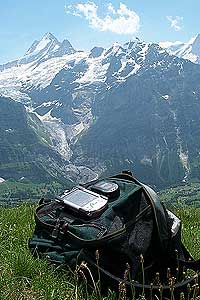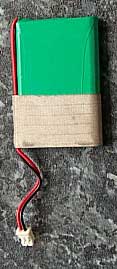|
The GlobalSat BT308 in use
 Well this is what it is really all about not what it looks like or what is inside, but how does it work in real life. Well this is what it is really all about not what it looks like or what is inside, but how does it work in real life.
I have used the GlobalSat for over four weeks now as my primary GPS receiver. During this time it has been all over Europe, and had a much more stringent test than we normally give equipment. The picture to the right is my
iPAQ and the GlobalSat BT308 posing high up in the Swiss Alps.
But coming back down to earth what are the main features of the BT308 and how did they pan out. Primarily they are the GPS receiver of course, the Bluetooth connectivity and the Battery life.
The GPS Receiver
The GPS receiver is based on the SiRF StarII/LP chipset which is one of the most capable GPS engines available today.
When I powered up my receiver having been sent from Taiwan it managed to obtain a factory fix in 50 seconds. Very impressive. Since then I have had longer and shorter TTFF times, and only once had an extended TTFF. This at first concerned me. I reset the receiver and tried again and still no fix. I then got another receiver out and found that that could not get a fix either.
My benchmark for comparison was obviously the Emtac. Over the weeks I ran both receivers in parallel on my test bed and compared the strength of fix, number of satellites fixed, and positional accuracy. These two receivers where pretty much equal in these lab conditions. The GlobalSat is a very sensitive receiver, and seems to hold fixes well under most circumstances.
Out in the field again the performance was impressive. I put it through some pretty nasty environments, where you would expect a GPS to fail, and it did, but it surpassed my expectations. With the two screen shots below I was in some pretty extreme locations (for GPS reception).
The left hand shot, from Fugawi UK, shows a gap in reception for about 500yards, this was taken at the bottom of a steep ravine with heavy Conifer tree coverage. When the fix was there it was accurate.
The right hand shot, using Memory Map Navigator, shows the approach up another tree covered ravine. Here again you can see the loss of signal for about a quarter of a mile, and also the effect of the reflected signals providing an erroneous fix location. In this case the fix stabilised and reported the correct position with a fix on only 2 satellites.
Don't get me wrong the above may sound somewhat negative, but in fact it is very positive. This sort of performance is not achieved by well known dedicated handheld devices!!
I have found that no matter which GPS receiver I am using allowing it to get a good strong fix before venturing into marginal signal areas will always give you better reception.
Sitting here writing this review the BT308 GPS is sitting on my windowsill and has a strong seven satellite fix. The other day I was talking to Dave when I noticed that I had a 3D Differential fix using the SBAS signals from the EGNOS system. I was beginning to wonder If I had set the receiver up correctly as I had not seen a differential fix in all my testing up until then.
The Bluetooth Connection
One of the main factors influencing the purchase of a device like this is the fact that it is Bluetooth enabled. When I had my 3870 this was a sheer joy no cables simple reconnection. I have since got an
iPAQ 5450 and am sorry to say HP have really taken a step back with this release. Enough whingeing it still works well if slightly irritatingly you are requested to select a Bluetooth device each time you connect.
All official Bluetooth products must go through the Bluetooth Qualification Program. When I started testing the GPS receiver qualification had not been achieved, this has since been accepted on 25 June 2003. The status can be checked on the Bluetooth Qualification List.
Throughout my testing the device communicated with both my PDA and my Laptop well with a couple of exceptions. One a common problem with BT devices is the selection of SiRF mode, the other was a lockup in the BT communications between GPS and PDA/Laptop both of these are known problems and are described in detail below.
One of the tests that I want to perform at some point is to test the range of the BT signal. I have certainly managed to retain a connection at a distance of 10 meters with line of sight. But I was not able to initiate a connection at that distance. This is something which though not critical may affect the way we use the devices. At some stage in the future we will organise some comparative testing of all Bluetooth GPS receivers.
For a couple of applications, in particular the supplied GPSInfo application, I had to make a manual connection to the GPS receiver before running the application. If I did not then the PDA would lock and a soft reset would be required.
These issues may not be the fault of the BT308, they may be related to the implementation of Bluetooth in the
iPAQ 5450.
 The Battery Life The Battery Life
This is the bit you have all been waiting for isn't it? The BT GPS receiver on steroids. has a large battery but how long does it last?
I was a bit disappointed to see the battery life being quoted as 8 hours continuous use. Especially as the Emtac had a smaller battery and achieved 8 hours in my test environment.
One of the first things that I did was put this to the test now I am obviously not going to sit here watching the GPS to see when it finally runs out of power, so I set up a much more scientific method.
When I started the GPS with a full charged power cell I noted the time. I then connected it to my PDA and ran up OziExplorer CE. I then selected the "Display NMEA Input" option from the menu and off it went recording the GPS input. I left this running all day, checking on it occasionally, it ran for 8 hours, then 9 hours, then 10 hours, then 11 hours...
It was exhausted finally after 11 hours and 28 minutes. Now this was not on trickle power, the was continuous as far as I can tell. I really didn't believe this so I did the same test the next day, and the next and the next. The result was that the battery life averaged a tad over 11 and a half hours throughout 12 tests. I just wish that the PDA battery life was that impressive.
So that is the controlled lab environment. What is it like in the field? Well on all but one occasion the battery outlasted me and my excursions for a day. On the one occasion it failed I had accidentally switched the unit on when putting it into my storage bag. I was out for a long day that day and the battery drained. This may be a design issue as the power switch is on the side where it can easily get caught. It is much more likely a "user" error, as it only happened the once. |